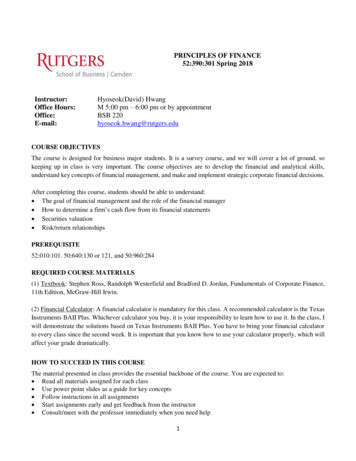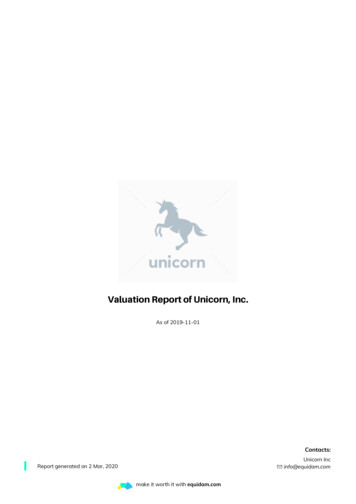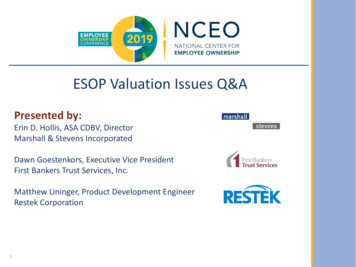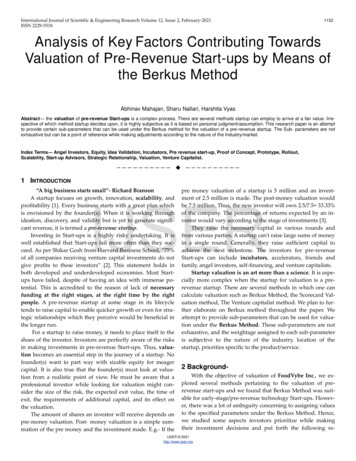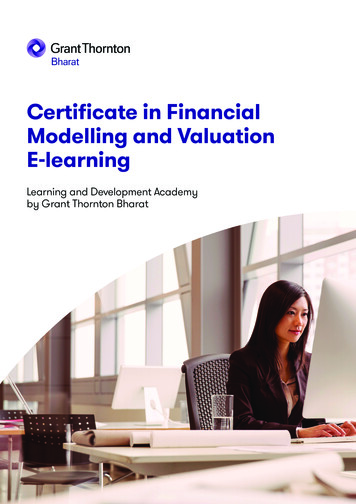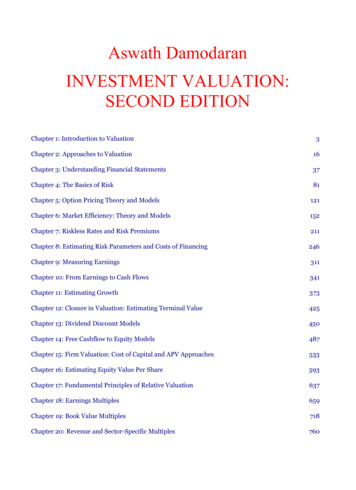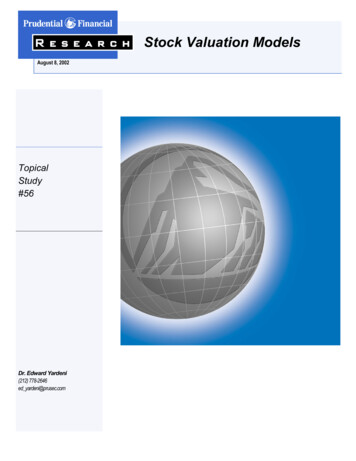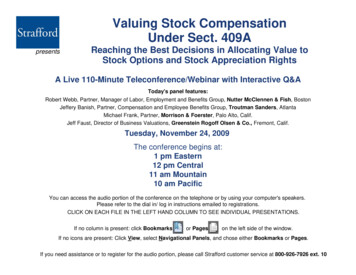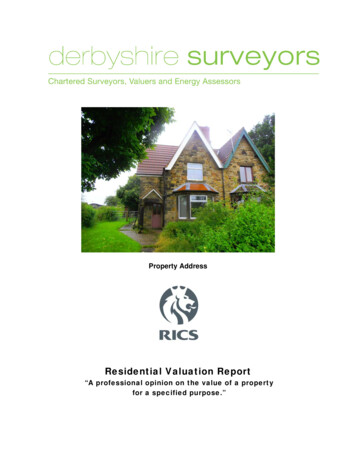
Transcription
2019 Valuation HandbookU.S. Industry Cost of CapitalMarket Results Through December 2019Duff & PhelpsCompany & SIC List
Cover design: Zach Rodheim, Design Manager, Duff & Phelps Publications BusinessCopyright 2019 Duff & Phelps, LLC. All Rights Reserved. The information and data presented in the2019 Valuation Handbook – U.S. Industry Cost of Capita (and its associated June, September, andDecember 2019 updates) has been obtained with the greatest of care from sources believed to bereliable, but is not guaranteed to be complete, accurate, or timely. Duff & Phelps, LLC(www.duffandphelps.com) and/or its data providers expressly disclaim any liability, including incidentalor consequential damages, arising from the use of the 2019 Valuation Handbook – U.S. Industry Cost ofCapital or any errors or omissions that may be contained in the 2019 Valuation Handbook – U.S.Industry Cost of Capital, or any other product (existing or to be developed) based upon the methodologyand/or data published herein.The Center for Research in Security Prices, LLC (CRSP ) provides some of the data used to calculate theanalyses herein. 2020. Center for Research in Security Prices, LLC (CRSP ). All rights reserved. CRSP is a registered trademark and service mark of Center for Research in Security Prices, LLC and has beenlicensed for use by Duff & Phelps, LLC. The Duff & Phelps publications and services are not sponsored,sold or promoted by CRSP , its affiliates or its parent company.Public or internal distributions (e.g., posting data, information, charts, tables, and/or figures, orimages from the 2019 Valuation Handbook – U.S. Industry Cost of Capital to public or internal websites;using data, information, charts, tables, and/or figures, or images from the 2019 Valuation Handbook –U.S. Industry Cost of Capital in marketing materials) is expressly forbidden, and no part of the 2019Valuation Handbook – U.S. Industry Cost of Capital may be reproduced or used in any form or by anyother means – graphic, electronic, or mechanical, including photocopying, recording, taping, orinformation storage and retrieval systems – without Duff & Phelps LLC’s prior, written permission.To obtain permission, please write to: Cost of Capital Navigator, Duff & Phelps LLC, 311 S. Wacker Dr.,Suite 4200, Chicago, IL 60606. Your request should specify the data or other information you wish to useand the manner in which you wish to use it. In addition, you will need to include copies of any charts,tables, and/or figures that you have created based on that information. There is a 1,500 processing feeper request. There may be additional fees depending on your proposed usage. One of the sources of rawdata used to produce the derived data and information in the 2019 Valuation Handbook – U.S. IndustryCost of Capital is Morningstar, Inc. Use of raw data from Morningstar to produce the derived data andinformation herein does not necessarily constitute agreement by Morningstar, Inc. of any investmentphilosophy or strategy presented in this publication.The forgoing does not preclude End-Users from citing the 2019 Valuation Handbook – U.S. Industry Costof Capital for End-User’s own internal business purposes, which includes the ability to provide limitedcitations to End-User’s direct clients solely for the purpose of performing services for such direct clientsin the ordinary course of End-User’s business activities.Published by:Duff & Phelps, LLC311 South Wacker DriveSuite 4200Chicago, IL 60606(312) 697-4600www.duffandphelps.com
About Duff & PhelpsDuff & Phelps is the global advisor that protects, restores and maximizes value for clients in the areasof valuation, corporate finance, investigations, disputes, cyber security, compliance and regulatorymatters, and other governance-related issues. We work with clients across diverse sectors, mitigatingrisk to assets, operations and people. With Kroll, a division of Duff & Phelps since 2018, our firm hasnearly 3,500 professionals in 28 countries around the world. For more information, visitwww.duffandphelps.com.2019 Valuation Handbook – U.S. Industry Cost of Capital (data through December 31, 2019); Company and SIC List4
Additional ResourcesDuff & Phelps is transitioning most of its valuation data resources form print delivery to a new onlinedelivery platform, the “Cost of Capital Navigator”. The Cost of Capital Navigator guides the Analystthrough the process of estimating the cost of capital, a key component of any valuation analysis.1Tolearn more about the Cost of Capital Navigator, visit dpcostofcapital.com.The history and future of Duff & Phelps data resources are discussed below.Duff & Phelps’ Valuation Digital Solutions (formerly the Duff & Phelps Business Publishing Group) hasauthored five books that focus on U.S. and international valuation theory, data, and risk premia (e.g.,equity risk premia, risk free rates, size premia, industry risk premia, betas, industry multiples, and otherstatistics, etc.) for use in valuation models.Duff & Phelps produces one book that focuses on U.S. capital markets performance data (i.e., the historyof returns of the capital markets in the U.S. from 1926 to the present). This resource, the Stocks, Bonds,Bills, and Inflation (SBBI ) Yearbook, has been published for over 30 years.2 The SBBI Yearbook doesnot provide extensive valuation data or methodology.3Each of the (i) U.S. and international valuation data resources, and the (ii) U.S. asset class performancedata resources are discussed in detail in the following sections.123The Cost of Capital Navigator includes both U.S. and international (i) cost of equity capital estimates, and (ii) weighted average cost ofcapital (WACC) estimates (subscription required). For more information or to purchase, visit: dpcostofcapital.com.“Stocks, Bonds, Bills, and Inflation ” and “SBBI ” are registered trademarks of Morningstar, Inc. All rights reserved. Used with permission.Morningstar previously published two “Ibbotson SBBI ” yearbooks: (i) The SBBI “Classic” Yearbook, which is now produced byDuff & Phelps as the “SBBI Yearbook” starting in 2016 (the word “Classic” was dropped from the title), and (ii) the SBBI “Valuation”Yearbook, which was discontinued by Morningstar in 2013. The former Ibbotson/Morningstar SBBI Valuation Yearbook was replaced bythe Duff & Phelps Valuation Handbook – U.S. Guide to Cost of Capital in 2014, and published annually as a hardcover book through 2018.Starting in 2018, Duff & Phelps will not publish a commercially available physical version of the Valuation Handbook – U.S. Guide to Costof Capital that includes the data exhibits; the essential valuation data from the data exhibits will be available only in the Cost of CapitalNavigator online platform. To learn more about the Cost of Capital Navigator, visit: dpcostofcapital.com.2019 Valuation Handbook – U.S. Industry Cost of Capital (data through December 31, 2019); Company and SIC List5
U.S. and International Valuation Data ResourcesDuff & Phelps produces five valuation data resources. The first four of these are the “ValuationHandbooks”. Three of the four Valuation Handbooks have already been transitioned over to digitaldelivery on the online Cost of Capital Navigator platform at dpcostofcapital.com. A summary of thestatus of the four Valuation Handbooks is provided in Figure 1.Figure 1: The Four Duff & Phelps Valuation HandbooksValuation HandbookStatusValuation Handbook –U.S. Guide to Cost of Capital Now available (exclusively) in the Cost of Capital Navigator'sU.S. Cost of Capital ModuleValuation Handbook –U.S. Industry Cost of Capital Now available (exclusively) in the Cost of Capital Navigator'sU.S. Industry Benchmarking ModuleValuation Handbook – International Guide to Cost of CapitalNow available (exclusively) in the Cost of Capital Navigator'sInternational Cost of Capital ModuleValuation Handbook –International Industry Cost of CapitalScheduled to be added to the Cost of Capital Navigator in2020 as the International Industry Benchmarking ModuleThe fifth valuation data resource is the Cost of Capital: Applications and Examples 5th edition, byShannon P. Pratt and Roger K. Grabowski (John Wiley & Sons, Inc., 2014). There are presently no plansto transition the information and data from this book over to the Cost of Capital Navigator platform. Asummary of the status of the Cost of Capital: Applications and Examples, 5th edition is provided in Figure2.Figure 2: The Cost of Capital: Applications and Examples, 5th editionAdditional Valuation ResourceStatusCost of Capital: Applications andExamples 5th editionContinues to be published as a hardcover book. Will notbe added to Cost of Capital Navigator.A detailed description of each of the five Duff & Phelps valuation resources listed in Figure 1 and Figure 2is provided in the following sections.2019 Valuation Handbook – U.S. Industry Cost of Capital (data through December 31, 2019); Company and SIC List6
The Cost of Capital Navigators’s U.S. Cost of Capital ModuleThe essential valuation data previously published in the former Valuation Handbook – U.S. Guide to Costof Capital has been exclusively available in the new online Cost of Capital Navigator’s U.S. Cost of CapitalModule since 2018.The U.S. Cost of Capital Module includes two essential U.S. valuation data sets: The CRSP Deciles Size Study4 The Risk Premium Report Study5The U.S. Cost of Capital Module includes: Size Premia Industry Risk Premia Equity Risk Premia (ERPs) Risk-free Rates Risk Premia Over the Risk-free RateAnd other risk premia that analysts have used and trusted for years to develop cost of capital estimatesfor U.S. companies.For more information and to purchase the Cost of Capital Navigator’s U.S. Cost of Capital Module, visitdpcostofcapital.com.The Cost of Capital Navigators’s U.S. Industry Benchmarking ModuleThe essential industry-level data previously published in the former Valuation Handbook – U.S. IndustryCost of Capital has been exclusively available in the new online Cost of Capital Navigator’s U.S. IndustryBenchmarking Module since 2019.The U.S. Industry Benchmarking Module includes: 45Industry-level Cost of Capital Estimates (cost of equity capital, cost of debt capital, and weightedaverage cost of capital, or WACC),The CRSP Deciles Size Study was published in the Ibbotson Associates Stocks, Bonds, Bill, and Inflation (SBBI ) Valuation Yearbook from1999–2006, in the Morningstar/Ibbotson Stocks, Bonds, Bill, and Inflation (SBBI ) Valuation Yearbook from 2007–2013, in the Duff &Phelps Valuation Handbook – U.S. Guide to Cost of Capital from 2014–2017, and since 2018 has been available exclusively in the Duff &Phelps online “Cost of Capital Navigator” platform at dpcostofcapital.com.The Risk Premium Report was published as the PricewaterhouseCoopers Risk Premium Reports and Price Waterhouse Rick PremiumReports for years before 2002, as the Standard & Poor’s Corporate Value Consulting Risk Premium Report from 2002–2004, the the Duff &Phelps Risk Premium Report from 2005–2013, and in the Duff & Phelps Valuation Handbook – U.S. Guide to Cost of Capital from 2014–2017, and since 2018 has been available exclusively in the Duff & Phelps online “Cost of Capital Navigator” platform atdpcostofcapital.com.2019 Valuation Handbook – U.S. Industry Cost of Capital (data through December 31, 2019); Company and SIC List7
Plus detailed industry-level statistics for: Sales Market Capitlization Capital Structure Levered and Unlevered Betas Valuation Multiples Financial and Profitiability Ratios Equity Returns Aggregate Forward-Looking Earnings-Per-Share (EPS) Growth RatesAnd more. Over 300 critical industry-level data points are calculated for approximately 170 U.S.industries (depending on data availability). Industries are organize by standard industrial classification(SIC) code.The U.S. Industry Benchmarking Module can be used to benchmark, augment, and support the analyst'sown custom analysis of the industry in which a subject business, business ownership interest, security,or intangible asset resides.For more information and to purchase the Cost of Capital Navigator’s U.S. Industry BenchmarkingModule, visit dpcostofcapital.com.The Cost of Capital Navigators’s International Cost of Capital ModuleThe essential valuation data previously published in the former Valuation Handbook – InternationalGuide to Cost of Capital has been exclusively available in the new online Cost of Capital Navigator’sInternational Cost of Capital Module since 2020.The International Cost of Capital Module includes: Country Risk Premia (CRPs) for over 180 countries Relative Volatility (RV) Factors for over 70 countries Country-level Equity Risk Premia for 16 Countries Country-level Risk-Free Rates International Industry-Level Betas Tax Rates Inflation Rates2019 Valuation Handbook – U.S. Industry Cost of Capital (data through December 31, 2019); Company and SIC List8
And more. The International Cost of Capital Module can be used to estimate country-level cost of equitycapital globally, for 175 countries, from the perspective of investors based in any one of up to 56countries (depending on data availability).“Measuring the impact of country risk in determining the international cost of capital is one of the mostvexing issues in finance. Any company doing international cost of capital estimation must, at minimum,consult the Cost of Capital Navigator’s International Cost of Capital Modulel”.– Campbell R. Harvey, Professor of International Business at the Fuqua School of Business, DukeUniversityFor more information and to purchase the Cost of Capital Navigator’s International Cost of CapitalModule, visit dpcostofcapital.com.Valuation Handbook – International Industry Cost of CapitalThe Valuation Handbook – International Industry Cost of Capital will be printed and distributed as aphysical book in 2020, but the essential information and data from this book is scheduled to be added tothe Cost of Capital Navigator as the International Industry Benchmarking Module later in 2020.Purchasers of the 2020 Valuation Handbook – International Industry Cost of Capital will receive a copyof the physical 2020 book (and associated intra-year update). Purchasers will also be given access tothe book’s upcoming online equivalent, the Cost of Capital Navigator’s International IndustryBenchmarking Module as soon as the module becomes available.The Valuation Handbook – International Industry Cost of Capital (and upcoming online InternationalIndustry Benchmarkng Module) includes industry-level analyses for four global economic areas: The World6The European UnionThe EurozoneThe United KingdomEach of the four global economic area’s industry analyses are presented in three currencies: (i) the euro( or EUR), (ii) the British pound ( or GBP), and (iii) the U.S. dollar ( or USD).The Valuation Handbook – International Industry Cost of Capital (and upcoming online InternationalIndustry Benchmarking Module) include: 6Industry-level Cost of Capital Estimates (cost of equity capital, cost of debt capital, and weightedaverage cost of capital, or WACC)In the Valuation Handbook – International Industry Cost of Capital, “World” companies are defined as companies that (i) are componentsof the MSCI ACWI IMI, and (ii) satisfy the rigorous screening requirements that are employed to define the company sets user therein.2019 Valuation Handbook – U.S. Industry Cost of Capital (data through December 31, 2019); Company and SIC List9
Plus detailed industry-level statistics for: SalesMarket CapitalizationCapital StrucutreLevered and Unlevered BetasValuation MultiplesFinancial and Profitability RatiosEquity ReturnsAggregate Forward-looking Earnings-Per-Share (EPS) Growth RatesAnd more. Over 300 critical industry-level data points are calculated for each industry (depending ondata availability). Industries are organized by global industry classification standard (GICS) code.The Valuation Handbook – International Industry Cost of Capital can be used to benchmark, augment,and support the analyst's own custom analysis of the industry in which a subject business, businessownership interest, security, or intangible asset resides.For more information and to purchase the 2020 Valuation Handbook – International Industry Cost ofCapital visit: duffandphelps.onfastspring.com/books.Purchasers of the 2020 Valuation Handbook – International Industry Cost of Capital will receive a copyof the physical 2020 book (and associated intra-year update). Purchasers will also be given access tothe book’s upcoming online equivalent, the Cost of Capital Navigator’s International IndustryBenchmarking Module as soon as the module becomes available. For more information about the Duff &Phelps online Cost of Capital Navigator platform, visit dpcostofcapital.com.The Cost of Capital: Applications and Examples, 5th editionThere are presently no plans to add the information and data from the Cost of Capital: Applications andExamples (5th edition) to the Duff & Phelps online Cost of Capital Navigator platform. This book willcontinue to be published as a hardcover book.The Cost of Capital: Applications and Examples 5th edition, by Shannon P. Pratt and Roger J. Grabowski(John Wiley & Sons, Inc., 2014) is the authoritative, comprehensive overview of valuation theory, bestpractices, and proper use of data. This book puts an emphasis on practical application.The Cost of Capital: Applications and Examples 5th edition is a one-stop shop for background andcurrent thinking on the development and uses of rates of return on capital. This book contains expandedmaterials on estimating the basic building blocks of the cost of equity capital, the risk-free rate, and theequity risk premium, plus in-depth discussion of the volatility created by the 2008 financial crisis, thesubsequent recession and uncertain recovery, and how those events have fundamentally changed howwe need to interpret the inputs to the models we use to develop these estimates.2019 Valuation Handbook – U.S. Industry Cost of Capital (data through December 31, 2019); Company and SIC List10
The Cost of Capital: Applications and Examples 5th edition includes case studies providingcomprehensive discussion of cost of capital estimates for valuing a business and damages calculationsfor small and medium-sized businesses, cross referenced to the chapters covering the theory and data.This book puts an emphasis on practical application. To that end, this updated edition provides readerswith exclusive access to a companion website filled with supplementary materials, allowing you tocontinue to learn in a hands-on fashion long after closing the book. The Cost of Capital: Applications andExamples has been published since 1998 and is updated every several years. The 6th edition of this bookis tentatively scheduled for publication late 2021.“Shannon Pratt and Roger Grabowski have produced a remarkably comprehensive review of thesubject it is a work that valuation practitioners, CFOs, and others will find an invaluable reference”.– Professor Richard Brealey, Emeritus Professor of Finance, London Business School“Estimating the cost of capital is critical in determining the valuation of assets, in evaluating the capitalstructure of corporations, and in estimating the long-run expected return of investments. Shannon Prattand Roger Grabowski have the most thorough text on the subject, not only providing various estimationmethods, but also numerous ways to use the cost of capital”.– Professor Roger G. Ibbotson,, Professor Emeritus of Finance at the Yale School of Management,Chairman of Zebra Capital LLC, and former Chairman and founder of Ibbotson Associates, now part ofMorningstar, Inc.To learn more about Cost of Capital: Applications and Examples 5th edition, visit:www.wiley.com/buy/9781118555804.2019 Valuation Handbook – U.S. Industry Cost of Capital (data through December 31, 2019); Company and SIC List11
U.S. Asset Class Performance DataStocks, Bonds, Bills, and Inflation (SBBI ) YearbookThere are presently no plans to add the information and data from the Stocks, Bonds, Bills, and Inflation (SBBI ) Yearbook to the Cost of Capital Navigator platform. This book will continue to be published as ahardcover book.The Stocks, Bonds, Bills, and Inflation (SBBI ) Yearbook (updated annually) has been the definitiveannual resource for historical U.S. capital markets performance data for over 30 years.Starting with the 2016 edition, the Stocks, Bonds, Bills, and Inflation (SBBI ) Yearbook has beenproduced by Duff & Phelps. The SBBI Yearbook was previously published by Morningstar, Inc. under thename “Ibbotson Stocks, Bonds, Bills, and Inflation (SBBI ) Classic Yearbook”.7, 8This book includes returns, index values, and statistical analyses of U.S. large company stocks, smallcompany stocks, long-term corporate bonds, long-term government bonds, intermediate-termgovernment bonds, U.S. Treasury bills, and inflation from January 1926 to present (monthly). Anyoneserious about investments or investing needs an appreciation of capital market history. Such anappreciation, which can be gained from this book, is equally valuable to the individual and institutionalinvestor, practitioners and scholars in finance, economics, and business; portfolio strategists, andsecurity analysts seeking to benchmark their own investment performance. The SBBI Yearbook is athinking person’s guide to using historical data to understand the financial markets and make decisions.To learn more about the Stocks, Bonds, Bills, and Inflation (SBBI ) Yearbook, visit:duffandphelps.onfastspring.com/books.78The SBBI Classic Yearbook (as it was known at that time) was published by Morningstar, Inc. from 2007 through 2015, and by IbbotsonAssociates in years prior to 2007. Beginning with the 2016 edition, the SBBI Yearbook (the word “Classic” was dropped from the title) hasbeen produced by Duff & Phelps.The SBBI Yearbook provides historical “performance” data of U.S. asset classes, while the other Duff & Phelps data resources provide“valuation” data. Specifically, the other Duff & Phelps data resources focus on U.S. and international valuation data and risk premia (e.g.,equity risk premia, risk-free rates, size premia, industry risk premia, betas, industry multiples and other statistics, etc.) for use in valuationmodels, while the SBBI Yearbook (this book) is (i) a history of the returns of the capital markets in the U.S. (thus the name, “Stocks, Bonds,Bills, and Inflation ,” or “SBBI ”) from 1926 to the present, and (ii) an analysis of the relative performance of U.S. asset classes. The SBBI Yearbook has been published annually for over 30 years. The SBBI Yearbook does not provide extensive valuation data or methodology.2019 Valuation Handbook – U.S. Industry Cost of Capital (data through December 31, 2019); Company and SIC List12
Industry-Level Cost of Capital EstimatesThe 2019 Valuation Handbook – U.S. Industry Cost of Capita and the online U.S. IndustryBenchmarking Module at dpcostofcapital.com provides eight (8) cost of equity capital estimates foreach of the industries covered in the book:9, 101) Capital Asset Pricing Model (CAPM)112) CAPM Size Premium (using the CRSP Deciles Size Study)3) Build-up Industry Risk Premium (using the CRSP Deciles Size Study)4) CAPM Size Premium (using the Risk Premium Report Study)5) Build-up Risk Premium Over the Risk-free Rate (using Risk Premium Report Study)6) 1-Stage Discounted Cash Flow (DCF) model7) 3-Stage DCF model8) Fama-French (F-F) 5-Factor ModelCost of debt capital and weighted average cost of capital (WACC) are also presented for eachindustry.12 WACC is calculated using the cost of equity capital estimated by each of the eightmodels, plus the cost of preferred capital input and the cost of debt capital input.9101112Depending on data availability; some industries may not include all estimates.In this list, the “CRSP Deciles Size Study” is the valuation data previously published on the “back page” of the Morningstar/Ibbotson SBBI Valuation Yearbook; the “Risk Premium Report Study” is the valuation data previously published in the Duff & Phelps Risk PremiumReport. Both of these key valuation data sets are now available exclusively in the online Duff & Phelps Cost of Capital Navigator U.S. Costof Capital Module at dpcostofcapital.com. The data and information in the former Valuation Handbook – U.S. Guide to Cost of Capitalwas published annually in a hardcover book from 2014 to 2017. Starting in 2018, the essential valuation data previously published in theValuation Handbook – U.S. Guide to Cost of Capital will be available exclusively in the new online Cost of Capital Navigator platform. Tolearn more about the Duff & Phelps Cost of Capital Navigator, visit: dpcostofcapital.com.This is CAPM calculated without any additional adjustments for “size”, or other factors (i.e., the traditional “textbook” or “base” CAPM).Depending on data availability; some industries may not include all estimates.2019 Valuation Handbook – U.S. Industry Cost of Capital (data through December 31, 2019); Company and SIC List13
Industry-Level Statistics, Capital Structure, Valuation Multiples, and BetasThe 2019 Valuation Handbook – U.S. Industry Cost of Capital and the online U.S. Industry BenchmarkingModule at dpcostofcapital.com also provide detailed statistics for sales, total assets, industryperformance, capital structure, various levered and unlevered beta estimates (e.g., ordinary least squares(OLS) beta, sum beta, downside beta, etc.), valuation (trading) multiples, financial and profitability ratios,equity returns, aggregate forward-looking earnings per share (EPS) growth rates, and more.Analysis of Capital Structure Including Off-Balance-Sheet LiabilitiesThe 2019 Valuation Handbook – U.S. Industry Cost of Capital and the online U.S. Industry BenchmarkingModule at dpcostofcapital.com provide statistics that enable the user to gauge the impact of “debt-like”off-balance-sheet items on the capital structure of the subject industry. These debt-equivalent liabilities(specifically, capitalized operating leases and unfunded pension obligations) are not only taken intoaccount by credit rating agencies when assigning a debt rating for a company, but should likely beconsidered when ascertaining the true financial (and equity) risk of the subject company as well.The capital structure (and unlevered betas) of each industry are calculated with and without these offbalance-sheet debt-equivalent items, so that the user can gauge how material these liabilities are for thesubject industry (see Appendices A and B).For a detailed discussion, see Cost of Capital: Applications and Examples 5th edition, by Shannon P.Pratt and Roger J. Grabowski, Chapter 20, “Other Components of a Business’s Capital Structure”.A Special Note on the Treatment of Off-Balance-Sheet LiabilitiesThe accounting treatment of leases under U.S. GAAP and IFRS has recently undergone a sweepingchange, replacing rules that have been in place for over 30 years. According to some estimates, thisaccounting change will ultimately bring trillions of dollars of off-balance-sheet liabilities into companies’balance sheets.13 The new standards have the following effective dates:Accounting Standards Codification Topic 842 Leases (ASC 842) under U.S. GAAP:13 Publicly traded companies and certain other SEC filers: Mandatory for fiscal years (includinginterim periods within those fiscal years) beginning after December 15, 2018. For calendar-yearcompanies, this means an effective date of January 1, 2019. All other entities: Mandatory for fiscal years (including interim periods within those fiscal years)beginning after December 15, 2020. For calendar-year companies, this means an effective dateof January 1, 2021. Early adoption allowed.See for example, “IFRS 16 – Effects Analysis” published by the IASB in January 2016. Accessible f.2019 Valuation Handbook – U.S. Industry Cost of Capital (data through December 31, 2019); Company and SIC List14
IFRS 16 Leases: All entities reporting under IFRS: Mandatory for fiscal years (annual periods) beginning on or afterJanuary 1, 2019.Early adoption allowed.While these standards are not fully converged, in simple terms they will both have the effect of requiringlessees to recognize lease liabilities and a corresponding right-of-use (RoU) asset on the balance sheetfor all lease agreements: U.S. GAAP adopted a dual lessee accounting model: Operating leases (previously an off-balancesheet item) are now recognized on the balance sheet. However, the rent (lease) expense willcontinue to flow through the income statement. Conversely, finance leases (formerly capitalleases) will continue to have a similar treatment as in previous rules. This means that there is norent expense related to the finance lease being recorded; rather amortization (of the RoU)and interest expenses associated with the lease agreement are recognized separately in theincome statement. IFRS introduced a single lessee accounting model: all the previous operating and capital leaseswill now be classified as finance leases and capitalized on the balance sheet. In the incomestatement, rent expense is now bifurcated between depreciation and interest expense. Thistreatment differs from the U.S. GAAP handling of operating leases.Accounting for lessors saw minimal changes and remains similar to previous rules.The December 31, 2019 data used in (this) U.S. industry analysis update was retrieved in early January2020 and reflected a relatively small number of companies that have adopted the new lease accountingrules on their annual financial statements. To ensure metrics are fully comparable across companiesand industries, the authors and other members of the V
Phelps Risk Premium Report from 2005-2013, and in the Duff & Phelps Valuation Handbook - U.S. Guide to Cost of Capital from 2014- 2017, and since 2018 has been available exclusively in the Duff & Phelps online "Cost of Capital Navigator" platform at dpcostofcapital.com.
